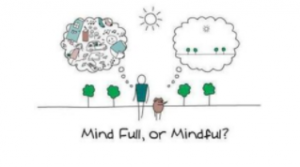
Mindfulness is the process of purposely bringing one’s attention to what is happening in the present moment, without judgment. It means consciously attending to being here, in this moment, right now. There is increasing evidence that mindfulness is a good thing. Mindfulness practices have been shown to reduce anxiety and depression and increase coping and various kinds of wellness. To a lesser extent, it can alleviate stress and improve your quality of life.
REFRIGERATOR LIST
- Transitions are hard. Always. Even under the best of circumstances, back-to-school season is stressful—there are new routines to create, new rhythms to find, and a lot of trial and error to tolerate in the meantime. This year is all of that multiplied by a thousand. Be patient with yourself, and with your little ones. We’re all going through a lot. If you can’t embrace the chaos (and many of us can’t), at least work toward tolerating it, accepting its presence and noting the feelings it evokes (a practice known as radical acceptance).
- Transitions make little things feel like big things. In the car on Monday, I wasn’t really angry at my son for asking over and over if we could go to McDonald’s (OK, that question is never not going to be annoying but I wasn’t angry). I was just feeling increasingly worried about all of the tasks I had to get done once we got home, and my son had the bad luck of asking the wrong question at the wrong time.
- The iceberg analogy is extremely helpful —use it. Snapping at my son? That was the tip of the iceberg, what everyone could see. My stress about the tasks I had to do? That was just below the surface. The amount of things to do in the past few months, with no sign of lifting anytime soon, is so overwhelming? That is the part that’s way underwater, and the part we actually need to address—that is, acknowledge, make space for, feel—in order for the snapping to stop.
- Take 5. Pick one of these for each of five days and then re-evaluate the usefulness of mindfulness.
- Mindful Hand Awareness Exercise. Grasp your hands tightly for five seconds, then release and notice how your hands feel. Keep your attention focused on the feeling for as long as you can. This is a wonderful exercise for getting out of your head and into your physical awareness.
- Music Appreciation. Yes, singing along to your favorite song counts as a mindfulness exercise! Pay attention to how this piece makes you feel. What emotions do you experience? What memories come up, and how do those memories make you feel? Savor these emotions and see if they carry over throughout the day.
- Close Your Eyes. Spend 5 minutes in silence while you appreciate your surroundings. Keeping your eyes closed helps to block out stimulation and sharpens your non-visual awareness.
- One Minute Breathing. This exercise can be done anywhere at any time, standing up or sitting down. Start by breathing in and out slowly. After a few seconds practice the 4-4-4: Inhale for a count of four, hold for a count of four, then exhale for a count of four. Let the breath flow in and out effortlessly. Repeat four times.
- Game of Fours. Notice four things in your day that generally go unnoticed. For example, fire up your senses and appreciate the sound of children giggling while riding their bikes, the fresh scent of soap in your shower, your coworker’s hearty laugh, or the brightest flowers in your garden.
*Created with the help of Psychology Today

